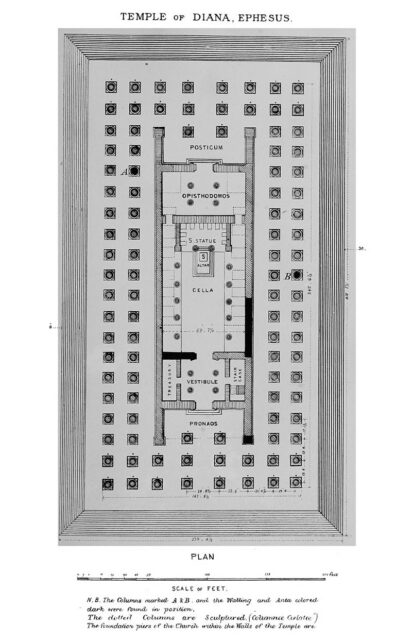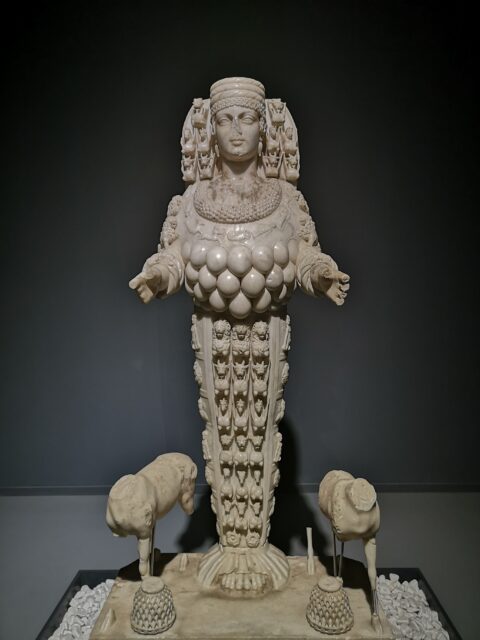In the heart of ancient Ephesus, a marvel once stood that captured the admiration of travelers from across the ancient world. The Temple of Artemis, a structure dedicated to the goddess of the hunt, was not just a place of worship but a symbol of architectural and cultural grandeur. Its foundations were laid on a history rich with tales of devotion and artistry, making it one of the Seven Wonders of the Ancient World. This temple, with its towering columns and majestic stature, served as a beacon for the ancient city, drawing pilgrims and tourists alike to bask in its glory.
The location and history of the Temple of Artemis

Nestled in the fertile lands of Ephesus, now part of modern-day Turkey, the Temple of Artemis once stood as a beacon of ancient architecture and religious devotion. This magnificent structure was not only a place of worship but also a symbol of the city’s wealth and dedication to the goddess Artemis, revered for her association with hunting, wild nature, and childbirth. Its location was strategically chosen, near the bustling city of Ephesus, making it a central point for pilgrims and traders alike. The Greek poet Antipater of Sidon, who saw multiple ancient wonders, stated, “… when I saw the house of Artemis that mounted to the clouds, those other marvels lost their brilliancy, and I said, ‘Lo, apart from Olympus, the Sun never looked on aught so grand.'” The temple’s history is marked by its construction in 550 BC, an endeavor sponsored by the Lydian King Croesus, which showcased the grandeur of Ionian architecture and artistry.
Over the centuries, the temple faced numerous challenges, including destruction by a devastating fire in 356 BC, coincidentally on the same night Alexander the Great was born. Despite such setbacks, the citizens of Ephesus, demonstrating their unwavering reverence for Artemis, rebuilt the temple, ensuring its legacy would endure. This resilience highlighted the cultural and religious significance of the temple in ancient times. Today, although the Temple of Artemis lies in ruins, its remnants continue to attract historians, archaeologists, and travelers from around the world, eager to glimpse into the past and marvel at the achievements of ancient civilizations.
Different phases of the Temple of Artemis throughout history

The Temple of Artemis has a history marked by several phases of construction and destruction, each contributing to the rich tapestry of its past. Initially, the temple was a modest structure, but it underwent significant transformations. The first version was created around 550 BC, under the patronage of King Croesus of Lydia, designed by the Cretan architect Chersiphron and his son Metagenes. This iteration was made primarily of wood, which made it vulnerable to fire. Unfortunately, it met its demise in a devastating blaze in 356 BC, an event that coincided with the birth of Alexander the Great, who later offered to rebuild it.
Following the fire, the Temple of Artemis was reconstructed on a grander scale, showcasing the pinnacle of Greek architecture and artistry. This new version was meticulously crafted with marble and boasted an impressive array of over 127 columns, each standing at 60 feet tall, designed to awe and inspire. The temple served not only as a religious sanctuary dedicated to the goddess Artemis but also as a marketplace and a cultural hub, attracting artisans, merchants, and tourists from across the ancient world. Unfortunately, this magnificent structure was not immune to the ravages of time and human conflict, eventually falling to a Gothic invasion in 262 AD. Despite its physical absence today, the Temple of Artemis continues to captivate the imagination of historians and archaeologists, symbolizing the extraordinary achievements of ancient engineering and religious devotion.
The Temple of Artemis’ rediscovery and cultural impact

The rediscovery of the Temple of Artemis brought it back into the limelight, centuries after it had fallen into obscurity. This ancient marvel, once one of the Seven Wonders of the Ancient World, had its remnants unearthed in the late 19th century by a team led by British archaeologist John Turtle Wood. His determination, fueled by historical accounts and local lore, guided him through challenging excavations near the modern town of Selçuk, Turkey. The discovery was monumental, revealing foundations and fragments that offered a glimpse into the temple’s former grandeur and the advanced architectural skills of its builders.
The excavation not only unearthed physical pieces of the past but also reignited interest in ancient Greek culture and the worship practices dedicated to Artemis. Scholars and historians were particularly fascinated by the scale and design of the temple, which was said to surpass all other structures of its time in splendor. The findings from the site, including sculptures and decorative elements, have since been distributed among museums worldwide, allowing a broader audience to appreciate the artistic and cultural significance of the Temple of Artemis. This rediscovery has played a crucial role in understanding the architectural achievements and religious practices of ancient civilizations, making it a key chapter in the story of human heritage.
The statue of Ephesian Artemis in the temple

Delving into the heart of Ephesus, the Temple of Artemis stands as a beacon of ancient architectural marvel and religious significance. This magnificent structure, dedicated to the goddess Artemis, was not only a place of worship but also a symbol of the city’s wealth and dedication to the divine. The Ephesian Artemis, known for her many breasts, symbolized fertility and was revered by a wide array of worshippers from across the ancient world. The temple itself, considered one of the Seven Wonders of the Ancient World, showcased the intricate craftsmanship and artistic prowess of the Ephesians.
Read more: Statue of Zeus at Olympia – Marvel of the Ancient World and Its Legacy
The stories and legends surrounding the Ephesian Artemis and her temple weave a rich tapestry of cultural and religious history, underscoring the complex relationship between the divine and the mortal realms. As we explore these ancient ruins, we are reminded of the enduring legacy of the Ephesians and their magnificent tribute to the goddess Artemis, a testament to human creativity and devotion.
